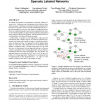104
click to vote
KDD
2008
ACM
16 years 1 months ago
2008
ACM
In this paper, we address the problem of learning when some cases are fully labeled while other cases are only partially labeled, in the form of partial labels. Partial labels are...
125
Voted
KDD
2008
ACM
16 years 1 months ago
2008
ACM
We present an approach to reconstructing chemical reaction networks from time series measurements of the concentrations of the molecules involved. Our solution strategy combines t...
119
Voted
KDD
2008
ACM
16 years 1 months ago
2008
ACM
We address the problem of classification in partially labeled networks (a.k.a. within-network classification) where observed class labels are sparse. Techniques for statistical re...
122
click to vote
KDD
2008
ACM
16 years 1 months ago
2008
ACM
In this article we describe a visual-analytic tool for the interrogation of evolving interaction network data such as those found in social, bibliometric, WWW and biological appli...
107
Voted
KDD
2008
ACM
16 years 1 months ago
2008
ACM
In an idealized gated radiotherapy treatment, radiation is delivered only when the tumor is at the right position. For gated lung cancer radiotherapy, it is difficult to generate ...
KDD
2008
ACM
16 years 1 months ago
2008
ACM
In this paper, we propose a set of novel regression-based approaches to effectively and efficiently summarize frequent itemset patterns. Specifically, we show that the problem of ...
120
Voted
KDD
2008
ACM
16 years 1 months ago
2008
ACM
Information diffusion, viral marketing, and collective classification all attempt to model and exploit the relationships in a network to make inferences about the labels of nodes....
132
click to vote
KDD
2008
ACM
16 years 1 months ago
2008
ACM
The effectiveness of knowledge transfer using classification algorithms depends on the difference between the distribution that generates the training examples and the one from wh...
129
click to vote
KDD
2008
ACM
16 years 1 months ago
2008
ACM
Low-rank approximations of the adjacency matrix of a graph are essential in finding patterns (such as communities) and detecting anomalies. Additionally, it is desirable to track ...
142
Voted
KDD
2008
ACM
16 years 1 months ago
2008
ACM
The input to an algorithm that learns a binary classifier normally consists of two sets of examples, where one set consists of positive examples of the concept to be learned, and ...



